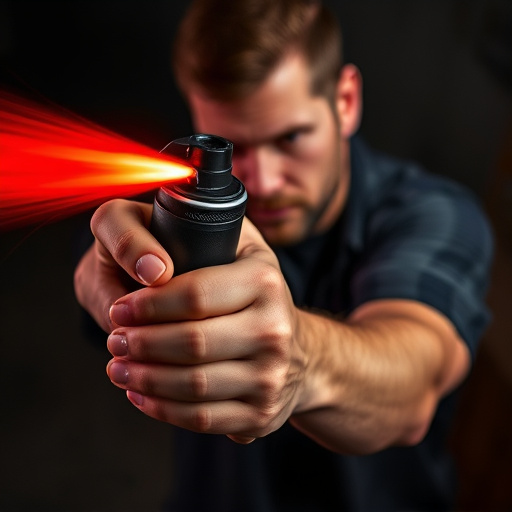Pepper spray is a critical non-lethal weapon for law enforcement, requiring comprehensive training that includes threat assessment, understanding spray effects, and de-escalation techniques. Choosing the right equipment involves factors like potency, range, pattern, duration, maintenance, compatibility, and ease of use under stress. Regular Pepper Spray Defense Training Tips ensure officers can deploy equipment safely and responsibly, enhancing public safety during volatile scenarios. This training includes scenario-based drills, de-escalation strategies, physical fitness exercises, and regular equipment familiarity. Effective use demands targeted application, proportionality, ventilation, and bystander safety.
“In the realm of law enforcement, effective control tools like pepper spray are indispensable assets. This article delves into the multifaceted world of law enforcement pepper spray equipment, offering comprehensive insights for officers. From understanding the chemical compound and its applications to choosing the right gear and mastering deployment techniques, we provide essential defense training tips. Learn about safety protocols, real-world scenarios, and best practices for using pepper spray as a strategic tool, ensuring officer preparedness and public safety.”
- Understanding Pepper Spray: A Law Enforcement Essential
- Choosing the Right Equipment for Effective Deployment
- Training Techniques: Maximizing Pepper Spray's Impact
- Safety and Handling Procedures for Officers
- Real-World Applications: Scenarios and Best Practices
Understanding Pepper Spray: A Law Enforcement Essential
Pepper spray, a powerful and non-lethal weapon, is an indispensable tool for law enforcement officers. It serves as both a deterrent and a defensive mechanism in various high-risk situations. Understanding how to use pepper spray effectively is crucial for maintaining public safety while minimizing potential harm to suspects and officers alike. Law enforcement agencies prioritize Pepper Spray Defense Training Tips to ensure their personnel are well-prepared to handle challenging scenarios safely.
This training goes beyond just the technical aspects of deploying the spray. It includes strategies for assessing threat levels, understanding the effects of pepper spray on the human body, and learning de-escalation techniques. By mastering these skills, officers can make informed decisions, ensuring they use the minimum force necessary while maintaining control over volatile situations.
Choosing the Right Equipment for Effective Deployment
Choosing the right pepper spray equipment is paramount for law enforcement agencies aiming to enhance officer safety and effectiveness during interactions with suspects. It involves more than just selecting a potent spray; it requires considering factors like application range, spray pattern, and duration of impact. Officers should undergo comprehensive Pepper Spray Defense Training Tips to understand how to deploy the equipment accurately and safely, maximising its stop-power potential while minimising collateral damage or unintended injuries.
Moreover, regular maintenance and calibration of pepper spray devices are crucial. Compatibility with existing gear, ease of use in high-stress situations, and adherence to departmental policies and legal guidelines should also guide decisions. By investing in well-suited equipment and ensuring proper training, law enforcement agencies can better equip their officers to handle volatile scenarios, promote public safety, and uphold the law effectively.
Training Techniques: Maximizing Pepper Spray's Impact
Effective pepper spray defense training tips are crucial for law enforcement officers to maximize the impact and safety of this crucial equipment. Beyond simple application techniques, well-rounded training should encompass scenario-based drills that simulate real-world encounters. By practicing de-escalation strategies alongside pepper spray deployment, officers learn to navigate volatile situations with a balanced approach.
Incorporating physical fitness and endurance exercises into the regimen ensures officers can handle the stress of active duty while effectively deploying pepper spray when needed. Additionally, regular maintenance and familiarity with equipment operation are vital. Through ongoing training, officers gain confidence in their ability to utilize pepper spray as a last resort, enhancing their overall safety and the public’s during high-risk situations.
Safety and Handling Procedures for Officers
Pepper spray is a powerful tool in law enforcement, but its use requires strict adherence to safety procedures. Officers must undergo comprehensive Pepper Spray Defense Training Tips to ensure they handle it correctly. This includes learning proper application techniques, understanding the spray’s range and duration, and knowing how to de-escalate situations effectively.
During training, officers are taught to aim for the center of mass, typically the eyes and face, to maximize effectiveness while minimizing collateral damage. They also learn to maintain a safe distance, as pepper spray can be dangerous both to the intended target and bystanders. Regular practice sessions help officers hone their skills, ensuring they can deploy the spray quickly and accurately in high-pressure situations.
Real-World Applications: Scenarios and Best Practices
In real-world scenarios, pepper spray is a valuable tool for law enforcement, offering both a deterrent and a non-lethal force option. It’s commonly used to disrupt and control crowds during protests or public disturbances, allowing officers to maintain order while minimizing physical harm. Additionally, it plays a crucial role in self-defense situations where an officer may face an armed suspect or someone with a deadly weapon.
Best practices for pepper spray deployment emphasize proportionality and safety. Training tips include ensuring proper ventilation at the scene, aiming for non-lethal targets like eyes and face, and using it only as a last resort when other de-escalation methods have failed. Regular Pepper Spray Defense Training helps officers stay prepared, improving their ability to make quick, effective decisions in high-pressure situations.
Pepper spray is a powerful tool in law enforcement, offering effective crowd control and self-defense capabilities. By understanding its properties, choosing the right equipment, and implementing proper training techniques, officers can maximize its impact while ensuring safe handling. Incorporating pepper spray defense training tips into routine practices is essential for maintaining public safety and officer well-being. These strategies, combined with real-world applications and best practices, enable law enforcement to effectively navigate challenging situations.
